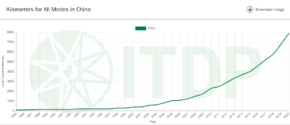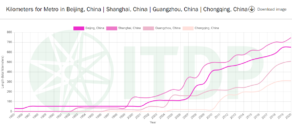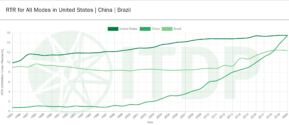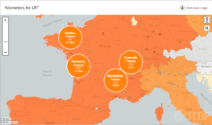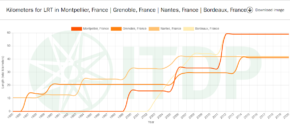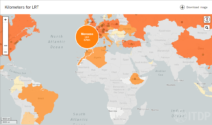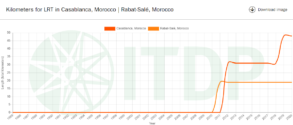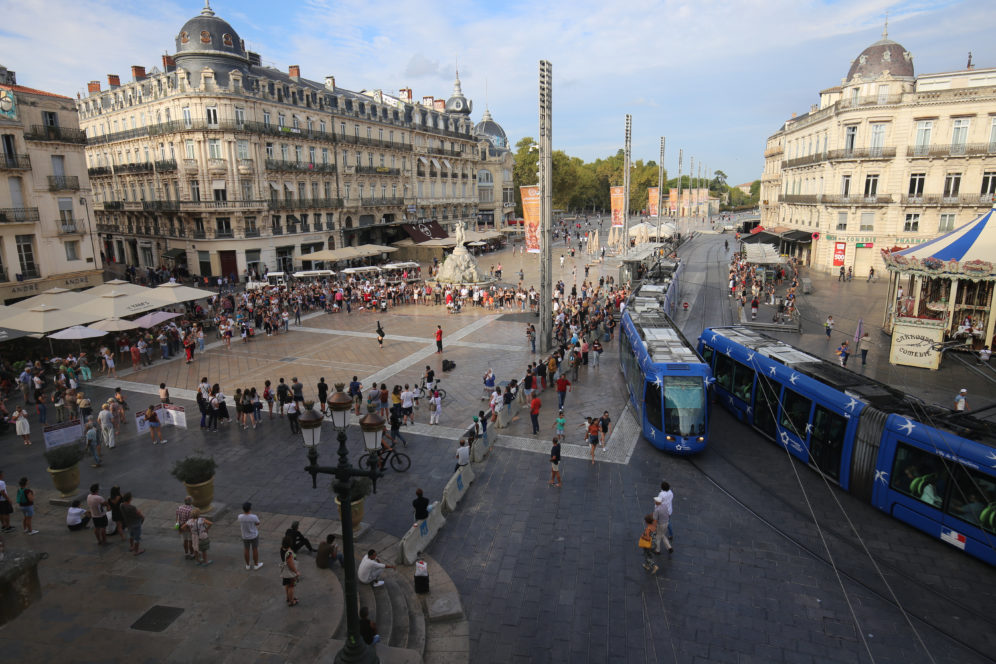 In Montpellier, France, a tram passes quietly, quickly, and safely through the city center.
In Montpellier, France, a tram passes quietly, quickly, and safely through the city center.
June 09, 2021
The World Stopped but Transit Kept Moving
Despite major setbacks, new corridors and hundreds of kilometers of rapid transit were launched in 2020
Public transportation, despite being an essential service, is frequently on the chopping block for municipal budget cuts. In 2020, transit worldwide was walloped by drastically lower ridership due to the pandemic and lockdown protocols.
Right now, as the world grapples with the pandemic – how to move through, or past it, the need to build back with more public transit is more urgent than ever. Not only has public transit been a lifeline to get many essential workers to their lifesaving jobs, but public transit remains an existential need in the face of climate change. Transportation serves as one of the fastest growing human-made sources of greenhouse gas emissions, and public transportation offers the best mobility solution to move people quickly and efficiently in the world’s rapidly urbanizing cities.
 ITDP has been at the forefront of public transportation for over thirty years; having always understood that public transportation is an integral part of a well-planned, safe, and accessible city. It is in this vein that ITDP has created the world’s first, publicly available Rapid Transit Database. This database, now available in interactive format, tracks rapid transit corridors from cities around the world and updates them annually. The online tool allows users to compare up to four locations and provides graphed data dating back to 1985. One important feature of the tool is the inclusion of Rapid Transit to Resident Ratio (RTR). This metric is entirely ITDP developed and measures a rapid transit system by comparing it to the population it serves. This ratio shows how prevalent a transit system is based on the population it is meant to serve. For example, in small city, fewer than 50 kilometers of rapid transit could have a high RTR because its small population is well served, whereas a large city might have hundreds of kilometers of rapid transit but might have a low RTR because its population is so large and vast. RTR provides a lens into the utility and usefulness of a rapid transit system.
ITDP has been at the forefront of public transportation for over thirty years; having always understood that public transportation is an integral part of a well-planned, safe, and accessible city. It is in this vein that ITDP has created the world’s first, publicly available Rapid Transit Database. This database, now available in interactive format, tracks rapid transit corridors from cities around the world and updates them annually. The online tool allows users to compare up to four locations and provides graphed data dating back to 1985. One important feature of the tool is the inclusion of Rapid Transit to Resident Ratio (RTR). This metric is entirely ITDP developed and measures a rapid transit system by comparing it to the population it serves. This ratio shows how prevalent a transit system is based on the population it is meant to serve. For example, in small city, fewer than 50 kilometers of rapid transit could have a high RTR because its small population is well served, whereas a large city might have hundreds of kilometers of rapid transit but might have a low RTR because its population is so large and vast. RTR provides a lens into the utility and usefulness of a rapid transit system.
The RTDB has been updated this year to include the surprising outcomes from 2020.
Despite the many horrors of 2020, there were some bright spots in rapid transit. While many corridor openings were delayed in the first half of the year, in the second half of 2020, 179 kilometers of Bus Rapid Transit, 1,116 kilometers of metro, and 28 kilometers of light rail were laid worldwide. Many of these openings occurred in China where rapid transit continues to be built at a staggering pace. In 2000, China had an RTR of 1.4 with only 381.7 kilometers of rapid transit countrywide. Today, China has 5642 kilometers of rapid transit and an RTR of 9.5. China’s population is so vast that even though its rapid transit has grown 14 times over, its RTR has only increased 9 times. Much of China’s growth has taken place in the past ten years and in 2020, China opened 42 number of corridors of total rapid transit. China’s strong national government has begun to embrace a policy of sustainability and sustainable transportation as it faces the existential threat of climate change. Even in 2020, at the heart of the pandemic, China was able to get public transportation back up and moving quickly. China’s rapid transit projects are part of decades long urban and development plans: these long term, financial commitments have allowed these systems to continue to grow despite the challenges of the pandemic.
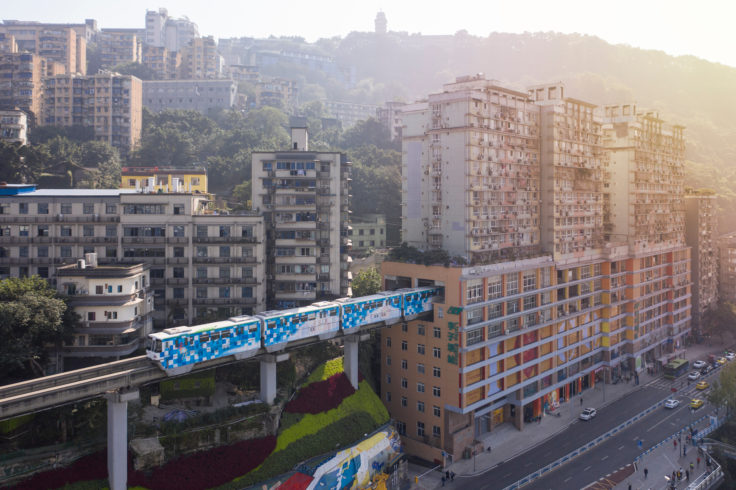
While China has been at the forefront of sustainable development in past years, other cities have placed themselves on the map this year. Peshawar, Pakistan, an ancient city in the Peshawar valley near the Afgahani border, is home to almost two million people and also considered the oldest city in Pakistan. Peshawar also just opened the fourth BRT corridor in Pakistan. In August, 2020, thanks to funding from the Asian Development Bank, TransPeshawar, a 13.9 kilometer BRT, was inaugurated. This system is part of a 20-year urban transport plan executed by the Khyber Pakhtunkhwa state government and includes electric hybrid buses and 32 stations.
There are some trends that can be observed in the past ten years. Light rail, or LRT, has seen gains worldwide. Light rail functions similar to BRT in that it is an above ground vehicle, but rather than being on a road, LRT vehicles are connected to a fixed track. France has invested significantly in light-rail. Now home to over 750 kilometers of trams, France has nearly doubled its LRT in the past ten years, often in its southern and western cities.
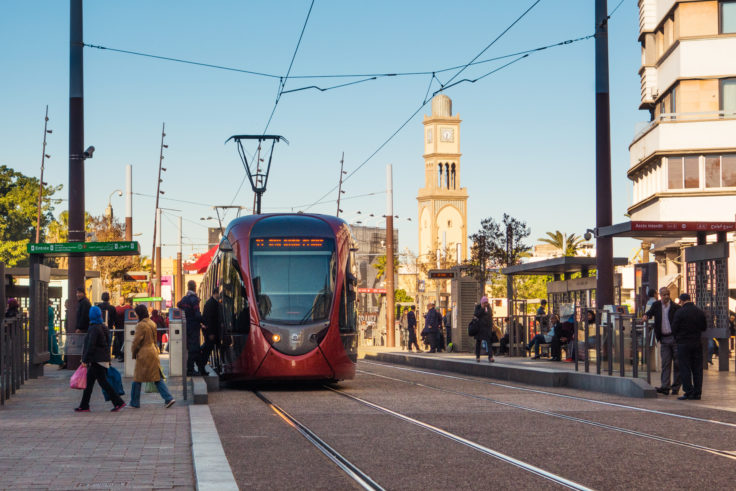
Of the four African nations with light rail systems, Algeria, Ethiopia, Morocco, and Tunisia, Casablanca’s expansion of its LRT to 48 kilometers now makes Morocco the African country with the most kilometers of LRT. Rapid transit corridors have been tied to economic development.

Metro has been a priority and focus of China, but in 2019 Doha, Qatar inaugurated an entire metro system of 76 kilometers and 37 stations. While Doha’s metro boasts driverless cars and can reach speeds of 100 kilometers per hour, it was built in low density areas. The availability of public transit could lead to further development around new stations. Tashkent, Uzebekistan, has also made major strides in its metro system. In 2020, Tashkent opened the first phase of its Circle Line. Also in 2020, Istanbul, Turkey, opened a new 18-km metro line, the M7 which is poised to carry 700,000 passengers per day. Like Peshawar, the ideas and funding of these new lines were born many years’ prior and were realized after almost a decade of construction. There are more corridors to be built in the next few years.
In looking at past developments, it is clear that long-term, multi-year commitments stand the test of time. In a year when the pandemic roiled every aspect of life worldwide, the fact that hundreds of kilometers of rapid transit were inaugurated is a testament to the power of committed to long term goals. This is also both a lesson and a warning for the future. To build sustainable transportation, cities and countries have to be willing to make long term commitments. These commitments withstand leadership and government changes and even the trials of the pandemic. With climate change already disrupting weather and migration patterns, a willingness to stick to goals is going to be even more important to realize change and sustainable growth.
The RTDB can help to keep cities accountable on this commitment and transformation. Now is the time to look forward and make plans – if not now, ten years from now many of the problems of pollution, air quality, and congestion will only be worse. Change starting now is the only path in an uncertain and dangerous future. Our planet needs it, and our people need it.

